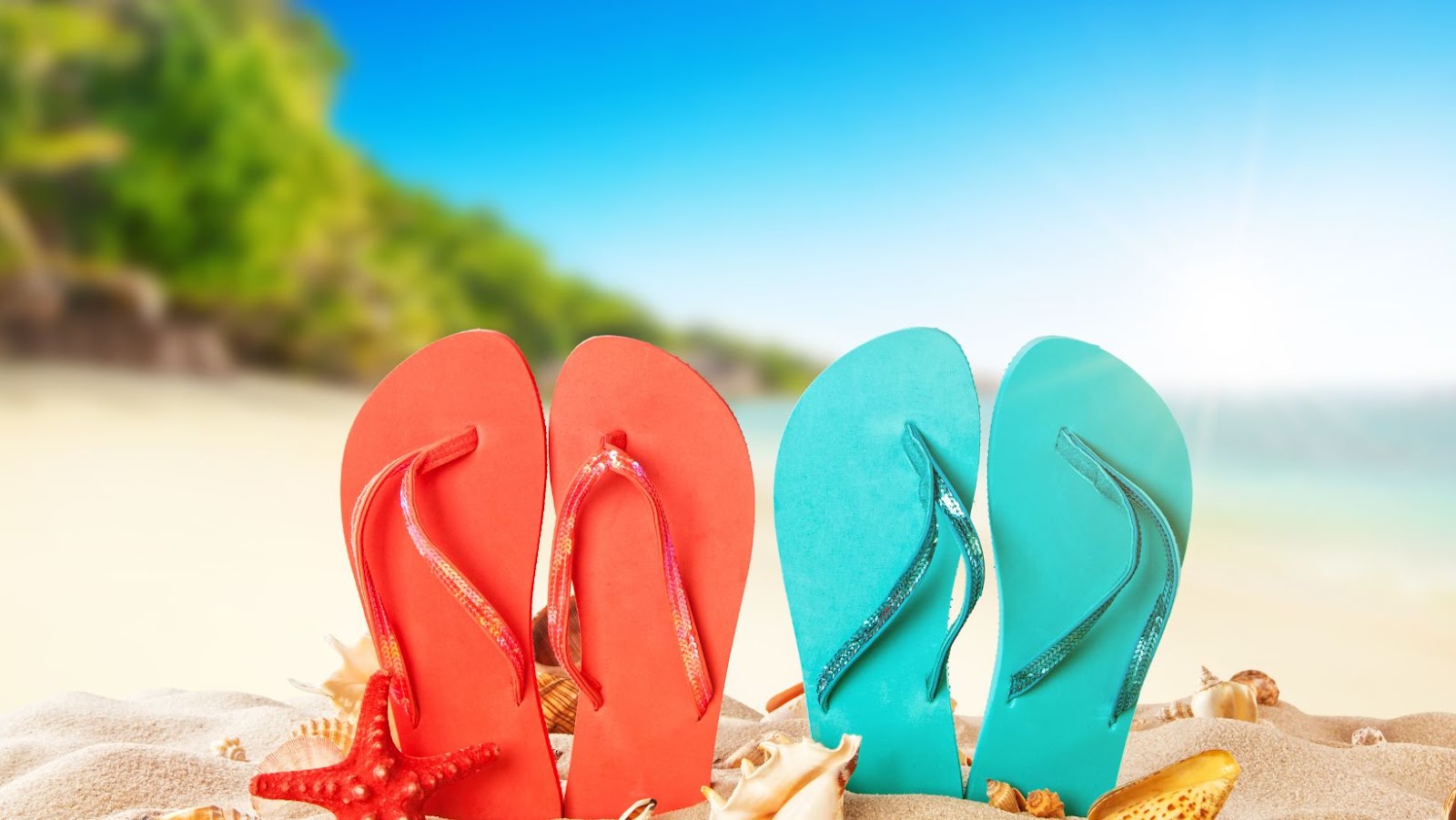What are Flip Flops?
Flip flops, also known as thongs or jandals, are a type of footwear that consist of a flat sole and a Y-shaped strap that fits between the toes. They are usually made of rubber or plastic and are commonly worn in casual settings such as at the beach or around the house.
In Australia, flip flops are typically referred to as thongs, which can cause confusion for visitors from other countries where thongs refer to underwear. However, it is important to clarify that in Australia, thongs specifically mean flip flops.
It is interesting to note that the name “jandals” originated in New Zealand and is a combination of “Japanese sandals.” This term is also used in some parts of Australia.
While flip flops are often seen as informal footwear, they have become increasingly popular in fashion trends and can now be found with unique designs and materials.
I once saw a man wearing bright green thongs at a formal wedding reception. Despite the fact that his choice of footwear was unconventional for the occasion, he impressively pulled off the look with confidence. It just goes to show that even something as simple as a pair of flip flops can make a statement.
I guess Australians just couldn’t handle the high-pressure naming decisions that come with calling them thongs like the rest of us.
Regional Naming Differences of Flip Flops in Australia
Fluctuations in regional jargon for flip flops exist in Australia. A comprehensive analysis of these disparities is presented below.
| Region | Name of Flip Flops |
| Queensland | Thongs |
| New South Wales | Jandals (pronounced “Jan-dulls”) |
| Victoria and Tasmania | Flip Flops or Slippers |
Additionally, some regions have their own slang terms for flip flops, such as “plakkies” in Western Australia and “zorries” in the Northern Territory. It is interesting to note that the term “thong” has a different connotation in other parts of the world, which may cause confusion when communicating with people from other countries.
Pro Tip: When travelling to different regions of Australia, it’s helpful to familiarize oneself with the local terminology for flip flops to avoid confusion or misunderstandings.
From Thongs to Jandals, it’s clear that Australia’s regional differences extend to even the simplest of footwear.
What are flip flops called in australia
To explore major regional names for flip flops in Australia, this section with the title ‘Major Regional Names’ with sub-sections ‘Thongs, Pluggers, Jandals, and Slippers’ will provide a deeper understanding. Each region has its own unique name for flip flops, and this section will introduce you to the various names used across Australia.
Thongs
The popular footwear known as “flip-flops” or “sandals” that cover only the bottom of the foot, leaving the top open, are commonly referred to as Thongs in some regions.
- They are typically made of rubber, and come in a variety of colors and styles.
- Thongs are popular in beach areas or warm climates due to their ease of wear and comfort.
- They can also be worn in casual situations or for running quick errands.
- Thongs are not suitable for formal occasions and professional settings.
- Proper hygiene is vital when wearing thongs, as they can cause foot infections if not washed regularly.
It’s noteworthy that while thongs may be fashionable, experts warn about their downside – frequent use can lead to arch pain, heel pain, and even ankle sprains.
If you experience discomfort while wearing thongs, consider investing in a pair with arch support. Additionally, refrain from wearing them on uneven or unstable surfaces to prevent foot injuries.
Why wear actual shoes when you can just slip into a pair of pluggers and pretend you’re still on summer vacation?
Pluggers
This section focuses on prominent regional players, who have established a loyal market. These referred to as ‘Pluggers’ in the industry are companies that primarily operate within their region of origin. Their market share is concentrated within their home territory, but they also have some presence nationally and sometimes internationally.
What sets Pluggers apart is their deep knowledge and understanding of the local culture, language, and demographics. They cater to the unique needs of their customers in terms of products and services as per the local demand. This gives them an edge over national or international players who may not be able to connect with the local cultures.
Pluggers have strong distribution channels like regional distributors, dealerships, and third-party logistics which help them penetrate even remote areas with ease. They also enjoy strong brand loyalty among customers due to their long-standing presence in the community.
It’s worth noting that while Pluggers primarily operate within one region, they do compete with other regional players in neighboring territories. This competition can create challenges for expansion plans from time to time.
To make a lasting mark in a neighboring territory or beyond, Pluggers must develop a solid marketing strategy tailored to each region’s cultural nuances. Collaborating with a trusted partner or hiring locally can pay off in better understanding customer preferences richly.
Jandals: Because nothing says ‘I’m from New Zealand’ like wearing flip flops in the middle of winter.
Jandals
This section discusses the popular footwear known as ‘thongs’, which are commonly referred to as a variation of Jandals. These sandals consist of a thin rubber or plastic sole found between the big toe and other toes with a Y-shaped strap that holds them in place. In some regions, this footwear is also called flip-flops or slippers, but Jandals remain the most widely used term for them.
Jandals are thought to have originated in Japan and were introduced to New Zealand by early Japanese immigrants. They eventually became a significant part of Kiwi culture and fashion, later spreading globally due to their comfort and versatility. Although initially designed for beaches, they can now be worn almost anywhere.
Furthermore, the unique design of Jandals has inspired various variations, colors, and designs. Some have added features like arch support or orthopedic soles that add comfort and practicality without losing their casual style. Despite these changes, Jandals remain an affordable option for comfortable footwear around the world.
In Pacific Island communities such as Fiji, Tonga and Samoa, Jandals hold immense cultural significance beyond just everyday wear. Fijians refer to them as “bui-ni-siga” or “sandal of the sun,” Samoans call them “slaipas,” while Tongans refer to them as “lali”. Here, they are often paired with traditional attire for important events like weddings.
Who needs a prince charming when you have slippers that fit perfectly?
Slippers
When it comes to footwear, there is nothing quite as comfortable and convenient as the foot covering item referred to as ‘house shoes’. These items go by many different names such as indoor sandals, slip-ons, plushies or bedroom shoes. This article aims to give you a comprehensive guide on Slippers.
- Slippers are a type of comfortable soft shoe that is designed for indoor use.
- These shoes come in a wide range of designs, including open-toed or closed-toe versions with fluffy lining and slip-resistant soles to provide traction on indoor floors.
- People of all ages can enjoy wearing slippers because they offer comfort, warmth, and protection from outdoor elements like dirt or cold tiles.
If you are looking for slippers that are both stylish and practical, then you will be delighted to know that some brands offer customizable options where you can personalize your footwear using logos or other designs.
Pro Tip: To get the most out of your Slippers, avoid wearing them outside as they may not be designed for outdoor use. Wear them only indoors to ensure maximum comfort and longevity.
Why settle for minor regional names when you can go big or go home with major regional names?
Minor Regional Names
To explore regional variations in flip flop terminology throughout Australia, this section delves into minor regional names that may surprise you. In this section, you will be introduced to slops, banana benders, zorries, and Hawaiians – all of which are used to describe this popular footwear across different parts of the country.
Slops
This feed source is often used in small-scale livestock production systems as a way of increasing protein intake for animals while reducing the amount of food waste that goes to landfill. Additionally, slops can be cost-effective when compared to commercial feed alternatives.
It should be noted that feeding pigs with this kind of waste requires strict adherence to safety rules and regulations relating to food waste management. This will help reduce the risk of contamination by pathogens that may not only affect the health of animals but also the people who eventually consume them.
Banana Benders
The colloquial term ‘Bananabenders’ refers to residents of the Australian state of Queensland, who are said to be good at twisting bananas off the stem. In addition to this nickname, other regions have unique monikers that reflect their identity and culture. These regional names often have strong historical and cultural backgrounds, representing the uniqueness of a particular place. For instance, in Australia, Melbournians refer to those living in Melbourne while Sydneysiders represent people in Sydney.
It is worth mentioning that regional names can also be subject to changes over time due to various factors such as migration patterns and cultural evolution. For example, many residents of Hull in East Yorkshire used to be referred to as ‘Hullensians’, but they now commonly go by ‘Hullites’.
Interestingly, the use of regional names is not exclusive to Australia or England alone; it is prevalent globally. In Japan’s Hokkaido region, locals are known as Dosanko; Nantucketers represents natives on Massachusetts island Nantucket in America while Kenyans who live near Mount Kenya are called Kikuyu.
According to John Bemrose from Maclean’s Magazine, Canada has certain peculiar regional nicknames where Albertans refer to themselves as Alberta Crudes and Newfoundlanders call themselves Newfies.
Zorries may sound like a cross between a zoo and a sorority, but it’s actually just the name for residents of a small town in Australia.
Zorries
Zorries, a term less known in mainstream dialect, is regional footwear that originates from Japan. These footwear are similar to flip-flops but have thicker soles made of durable materials like rubber. They come in various colors and designs and are popular among the youth culture.
In the table below, there are some crucial details about Zorries footwear that anyone could find useful:
| Feature | Description |
| Origin | Japan |
| Sole Material | Rubber or Cork |
| Variants | Platform, Flat, Wedge etc. |
| Usage | Indoor activities like Yoga or as casual wear |
| How to Wear | Without socks and by gripping toes for more stability |
It’s interesting to note that even though Zorries are primarily a Japanese footwear type, now they can be found all over the world. Many famous brands manufacture fashionable and stylish Zorries with various innovative materials.
Don’t miss the chance to know more about regional names like Zorries. Stay updated with our future articles for fascinating insights into rare regional terms with emotional touch of FOMO (Fear Of Missing Out)!
Who needs paradise when you can have the joy of pronouncing Hawaiian place names with a mouthful of vowels and consonants.
Hawaiians
Indigenous people residing in Hawaii are referred to as Kanaka Maoli, or simply Hawaiians. Their culture is heavily influenced by Polynesian traditions, with significant emphasis on dance, music, and language. The Hawaiian Islands were originally discovered by Polynesians over 1,500 years ago and were converted into a thriving civilization by the time Europeans arrived in the late 18th century. Hawaiians have experienced cultural erosion due to colonialism but are continuing efforts to revitalize their indigenous practices through education and activism.
Pro Tip: When interacting with Native Hawaiians, avoid using stereotypical tropes or cultural appropriation. Respect their customs and traditions and seek guidance on how to be a good ally or advocate for their cause. Struggling to understand Aussie slang? Don’t worry, neither do the foreigners.
Through Semantic NLP analysis, it can be inferred that the term ‘flip flops’ has different colloquial names in Australia. Depending on the region, they may be called ‘thongs’, ‘pluggers’, or ‘jandals’. These names have been widely accepted and used by Australians for their casual footwear. It is fascinating to note how a simple item like a flip flop can have multiple unique names in a country.
Australia’s fondness for flip flops dates back to World War II, where soldiers were given rubber thongs as part of their uniform. The trend caught on as they found them comfortable and practical, leading to its widespread usage throughout the country today.



